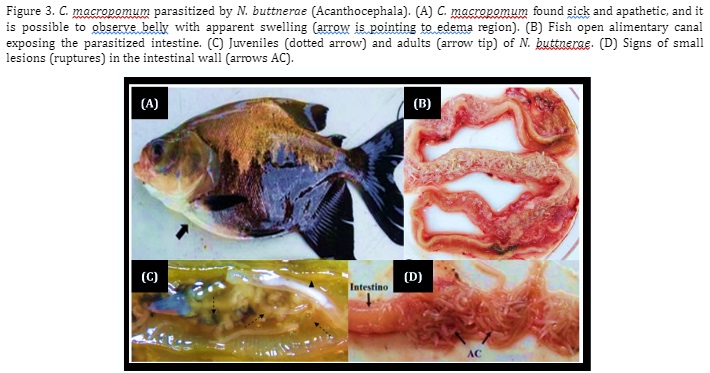Outbreaks of Neoechinorhynchus buttnerae (Acanthocephala) infection in raised semi-intensively Colossoma macropomum in Theobroma, Rondônia state, Western Amazon
DOI:
https://doi.org/10.21708/avb.2023.17.1.11344Keywords:
Fish farming; fish healthiness; intestinal parasite; preventive measures.Abstract
The aim of this study was to describe two outbreaks of Neoechinorhynchus buttnerae parasitizing Colossoma macropomum raised semi-intensively in the Theobroma municipality, Rondônia state, Brazil. It was reported by owner that the animals had a history of poor weight gain and decreased food intake. C. macropomum that weighed around 1.5 kg were clinically evaluated where the body surface, fins, buccal and brachial cavity were carefully analyzed and no changes were found. N. buttnerae was the only intestinal parasite found in the specimens studied, and its distribution pattern showes a preference for the posterior portion of the intestine of C. macropomum. All 50 fish examined were parasitized by at least one N. buttnerae. This parasite was found in the digestive system of the examined fish. 100% of prevalence, 430 of intensity, 8.6 of average intensity and average abundance were found. Although there was no record of mortalities due to acanthocephalosis, damage that compromised the feed conversion of the fish was recorded. C. macropomum were infected by ingesting a crustacean containing cystacanth, the infective larval form of the parasite. Damage, such as presence of nodules, hypertrophy of goblet cells, thickening of the muscle layer, metaplasia in muscle tissue, severe edema from leukocyte infiltration in blood vessels and necrotic foci, were found in the intestine due to high infection rates of N. buttnerae. That said, inspection activities are essential for the preservation of consumer and animal health.
Downloads

Downloads
Published
Issue
Section
License
Copyright (c) 2023 Acta Veterinaria Brasilica

This work is licensed under a Creative Commons Attribution 4.0 International License.
Autores que publicam na Acta Veterinaria Brasilica concordam com os seguintes termos: a) Autores mantém os direitos autorais e concedem à revista o direito de primeira publicação, com o trabalho simultaneamente licenciado sob a Licença Creative Commons Attribution que permite o compartilhamento do trabalho com reconhecimento da autoria e publicação inicial nesta revista. b) Autores têm autorização para assumir contratos adicionais separadamente, para distribuição não-exclusiva da versão do trabalho publicada nesta revista (ex.: publicar em repositório institucional ou como capítulo de livro), com reconhecimento de autoria e publicação inicial nesta revista. c) Autores têm permissão e são estimulados a publicar e distribuir seu trabalho online (ex.: em repositórios institucionais ou na sua página pessoal) a qualquer ponto antes ou durante o processo editorial, já que isso pode gerar alterações produtivas, bem como aumentar o impacto e a citação do trabalho publicado (Veja O Efeito do Acesso Livre).


 Esta obra está licenciada com uma Licença
Esta obra está licenciada com uma Licença 